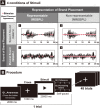Temporal and spectral EEG dynamics can be indicators of stealth placement
- PMID: 29904124
- PMCID: PMC6002479
- DOI: 10.1038/s41598-018-27294-4
Temporal and spectral EEG dynamics can be indicators of stealth placement
Abstract
Stealth placement marketing, where consumers are unaware that they are being marketed to, attempts to reduce the audiences' resistance to traditional persuasive advertising. It is a form of advertising that involves targeted exposure of brands or products incorporated in other works, usually with or without explicit reference to the brands or products. Brand placement can be presented in different visual and auditory forms in video programs. The present study proposed that different 'representations' (i.e., representable or non-representable) and 'sounds' (i.e., speech or musical sound) of brand placement can affect the viewers' perception of the brand. Event-related potential results indicated significant differences in P1, N1, P2, N270, and P3. Further, event-related spectral perturbation results indicated significant differences in theta, alpha, beta, and gamma (30-100 Hz), in the right parietal, right occipital area, and limbic lobe. 'Non-representable' or 'speech sound' brand placement induced significant temporal and spectral EEG dynamics in viewers.
Conflict of interest statement
The authors declare no competing interests.
Figures





Similar articles
-
That does not sound right: Sounds affect visual ERPs during a piano sight-reading task.Behav Brain Res. 2019 Jul 23;367:1-9. doi: 10.1016/j.bbr.2019.03.037. Epub 2019 Mar 25. Behav Brain Res. 2019. PMID: 30922941
-
Neural correlates of auditory distraction revealed in θ-band EEG.Neuroreport. 2012 Mar 7;23(4):240-5. doi: 10.1097/WNR.0b013e3283505ac6. Neuroreport. 2012. PMID: 22314684
-
Task-free auditory EEG paradigm for probing multiple levels of speech processing in the brain.Psychophysiology. 2018 Nov;55(11):e13216. doi: 10.1111/psyp.13216. Epub 2018 Aug 13. Psychophysiology. 2018. PMID: 30101984
-
Central processing of speech sounds and non-speech sounds with similar spectral distribution: An auditory evoked potential study.Auris Nasus Larynx. 2020 Oct;47(5):727-733. doi: 10.1016/j.anl.2020.02.008. Epub 2020 Feb 24. Auris Nasus Larynx. 2020. PMID: 32102744
-
Auditory representations for long lasting sounds: Insights from event-related brain potentials and neural oscillations.Brain Lang. 2023 Feb;237:105221. doi: 10.1016/j.bandl.2022.105221. Epub 2023 Jan 7. Brain Lang. 2023. PMID: 36623340 Review.
Cited by
-
Temporal and electroencephalography dynamics of surreal marketing.Front Neurosci. 2022 Oct 27;16:949008. doi: 10.3389/fnins.2022.949008. eCollection 2022. Front Neurosci. 2022. PMID: 36389218 Free PMC article.
-
A systematic review of the prediction of consumer preference using EEG measures and machine-learning in neuromarketing research.Brain Inform. 2022 Nov 14;9(1):27. doi: 10.1186/s40708-022-00175-3. Brain Inform. 2022. PMID: 36376735 Free PMC article. Review.
-
EEG signatures of low back and knee joint pain during movement execution: a short report.Front Rehabil Sci. 2023 Aug 16;4:1216069. doi: 10.3389/fresc.2023.1216069. eCollection 2023. Front Rehabil Sci. 2023. PMID: 37662545 Free PMC article.
References
-
- Azevedo, P. C. B. S. d. Perception of commercial brands and the emotional and social value: A spatiotemporal EEG analysis. (2010).
-
- Ohme R, Reykowska D, Wiener D, Choromanska A. Analysis of neurophysiological reactions to advertising stimuli by means of EEG and galvanic skin response measures. Journal of Neuroscience, Psychology, and Economics. 2009;2:21. doi: 10.1037/a0015462. - DOI
Publication types
MeSH terms
LinkOut - more resources
Full Text Sources
Other Literature Sources

